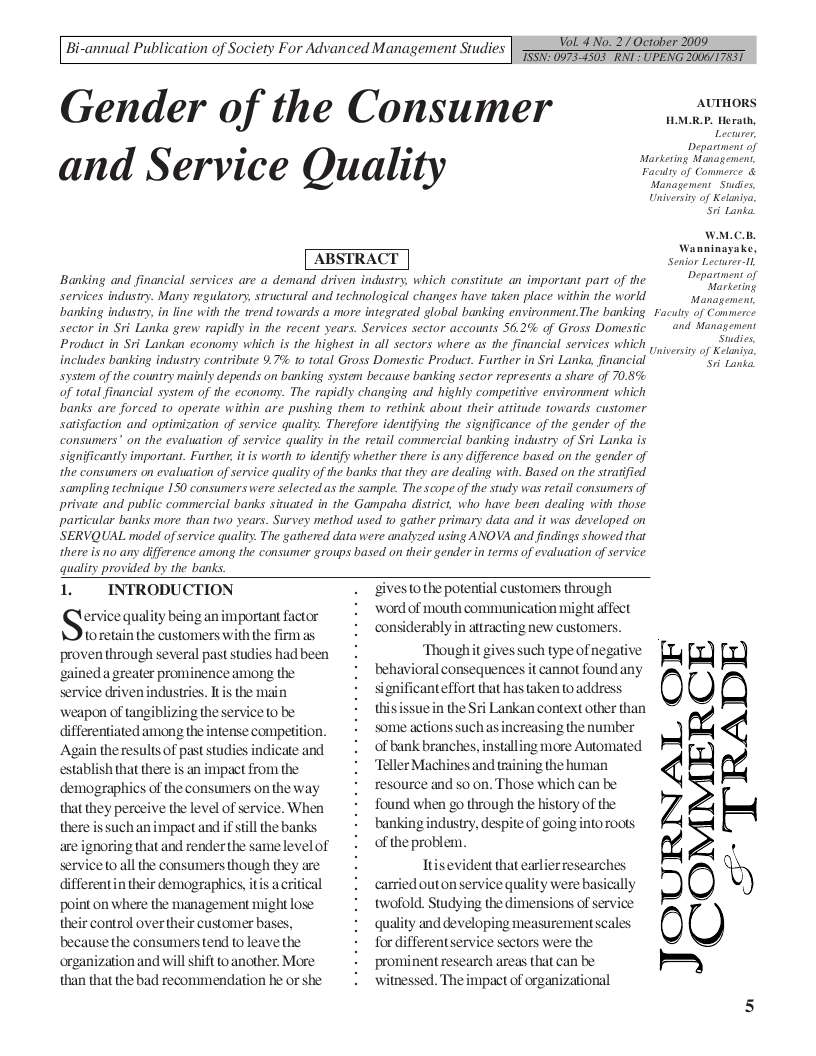Gender of the Consumer and Service Quality
DOI:
https://doi.org/10.26703/jct.v4i2.417Keywords:
Gender Study, Customer, Service Quality, Banking ServicesAbstract
The banking sector in Sri Lanka grew rapidly in the recent years. Services sector accounts 56.2% of Gross Domestic Product in Sri Lankan economy which is the highest in all sectors where as the financial services which includes banking industry contribute 9.7% to total Gross Domestic Product. Further in Sri Lanka, financial system of the country mainly depends on banking system because banking sector represents a share of 70.8% of total financial system of the economy. Therefore identifying the significance of the gender of the consumers’ on the evaluation of service quality in the retail commercial banking industry of Sri Lanka is significantly important. Further, it is worth to identify whether there is any difference based on the gender of the consumers on evaluation of service quality of the banks that they are dealing with. Based on the stratified sampling technique 150 consumers were selected as the sample. The scope of the study was retail consumers of private and public commercial banks situated in the Gampaha district, who have been dealing with those particular banks more than two years. Survey method used to gather primary data and it was developed on SERVQUAL model of service quality. The gathered data were analyzed using ANOVA and findings showed that there is no any difference among the consumer groups based on their gender in terms of evaluation of service quality provided by the banks.
Downloads
References
Allison N.K., Golden L.L., Mullet G.M. & Coogan, D. (1980). Sex-typed product images: the effects of sex, sex role self-concept and measurement implications, in Olsen, J.C. (Ed.), Advances in Consumer Research, 7, Association for Consumer Research, Ann Arbor, MI, pp. 604-9.
Bowen, J. (1990), Development of A Taxonomy of Services to Gain Strategic Marketing Insights. Journal of the Academy of Marketing Science, 18, 43-59.
Bowen, J.W., & Hedges, R.B. (1993), Increasing service quality in retail banking. Journal of Retail Banking, 15, 21-38.
Boulding W., Kalra A., Staelin, R., & Zeithaml, V.A. (1993), A dynamic process model of service quality: from expectations to behavioral intentions. Journal of Marketing Research, 30(3), 7-27.
Cronin J.J. Jr & Taylor, S.A., (1992), Measuring service quality: a re-examination and extension. Journal of Marketing, 56(2), 55-68.
Coughlin M., & O’Connor, P.J. (1985),Gender role portrayals in advertising: an individual differences analysis, in Hirschman, E.C. and Holbrook, M.B. (Eds), Advances in Consumer Research, 12, Association for Consumer Research, Ann Arbor, MI, 238-41.
Gainer, B. (1993), An empirical investigation of role of involvement with a gendered product . Psychology & Marketing, 10 (4), 265-83.
Gould S.J., & Stern, B.B., (1989), Gender schema and fashion consciousness. Psychology and Marketing, 6(2), 129-45.
Gronroos, C. (1988), Service quality: the six criteria of good perceived service quality. Review of Business, 9(3), 113- 29.
Gronroos, C. (1991), Strategic management and marketing in the service sector. Studentlitteratur-Chartwell-Bratt, Sweden
Jaffee, L.J. (1991), Impact of positioning and sex-role identity on women’s responses to advertising. Journal of Advertising Research, June/July, 57-64.
Jaffee L.J., & Berger P.D., (1988), Impact on purchase internet of sex-role identity and product positioning. Psychology & Marketing, 5 (3), 259-71.
Kahle L.R., & Homer, P., (1985), Androgyny and midday mastication: do real men eat quiche, in Hirschman, E.C. and Holbrook, M.B. (Eds), Advances in Consumer Research, Association for Consumer Research, Ann Arbor, MI, 242-6.
Lehtinen U., & Lehtinen J.R.,(1991),Two approaches to service quality dimensions”, The Service Industries Journal, 11(2) 287-303
McAlexander, James H., Kaldenberg Dennis O., Koenig, Harold F. (1994), Service quality measurement. Journal of Health care Marketing, 14,(3), 102-14
Parasuraman A., (1985), A conceptual model of service quality and its implications for future research. Journal of Marketing, 49(4) 41-50
Parasuraman A., Zeithaml, V.A., & Berry L.L., (1994), Moving forward in service quality research: measuring different levels of customer expectations, comparing alternative scales, and examining the performance-behavioral intentions Link, Marketing Science Institute working paper, Report No. 94-114.
Rust R.T., & Oliver R.L. (1994), Service quality: insights and managerial implications from the frontier,in Rust, R.T.and Oliver, R.L. (Eds), Service Quality: New Directions in Theory and Pr Oliver, R.L. (1993), A conceptual model of service quality and service satisfaction: compatible goals, different concepts, in Swartz T.A., Bowen, D.E. and Brown, S.W. (Eds), Advances in Service Marketing and Management: Research and Practice, JAI Press, Greenwich, CT, 65-85.
Schmitt B.H., Leclerc F., & Dube-Rioux, L. (1988), Sex typing and consumer behavior: a test of gender schema theory. Journal of Consumer Research, 15,122-8.

Downloads
Published
Issue
Section
License
Copyright (c) 2009 H. M. R. P. Herath, W. M. C. B. Wanninayake

This work is licensed under a Creative Commons Attribution 4.0 International License.










